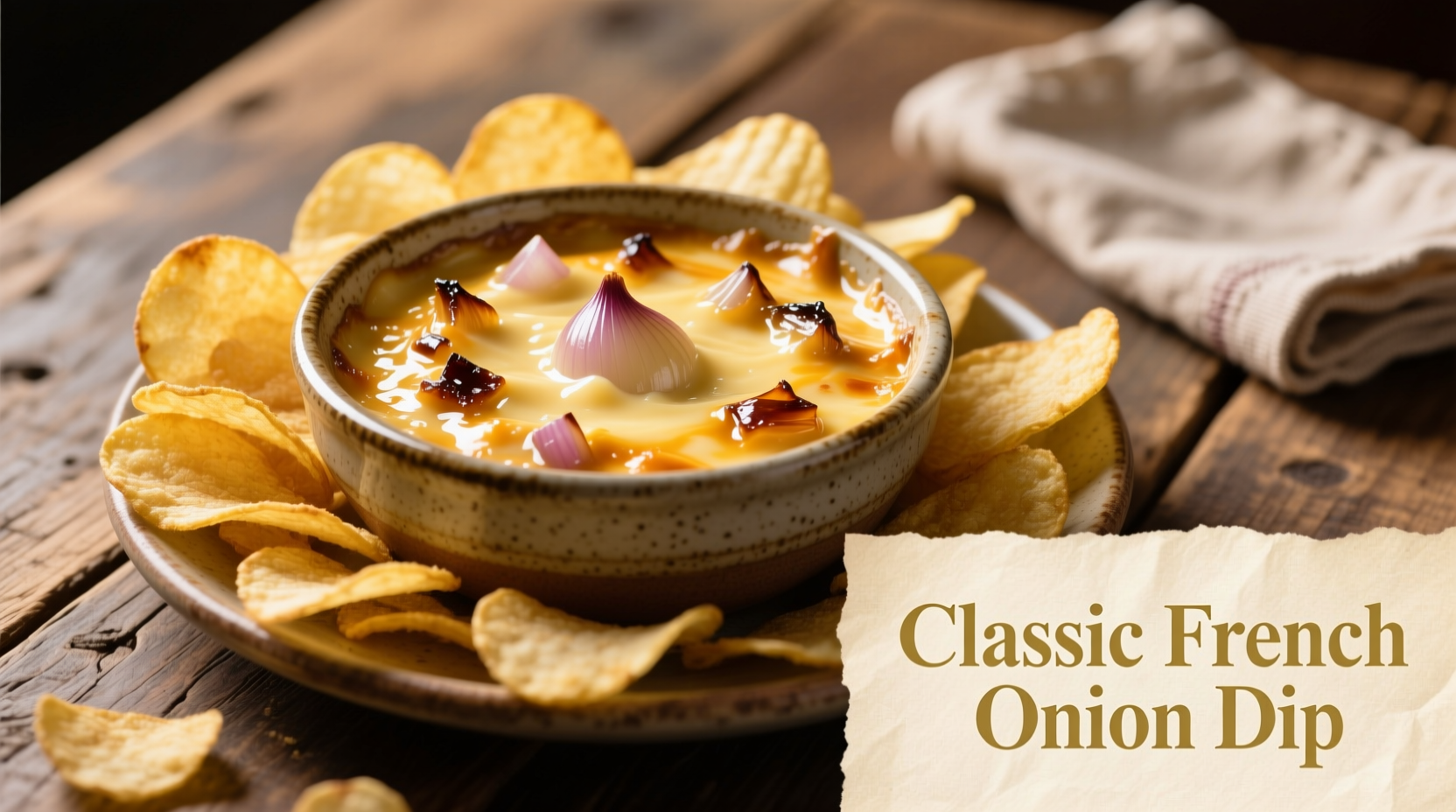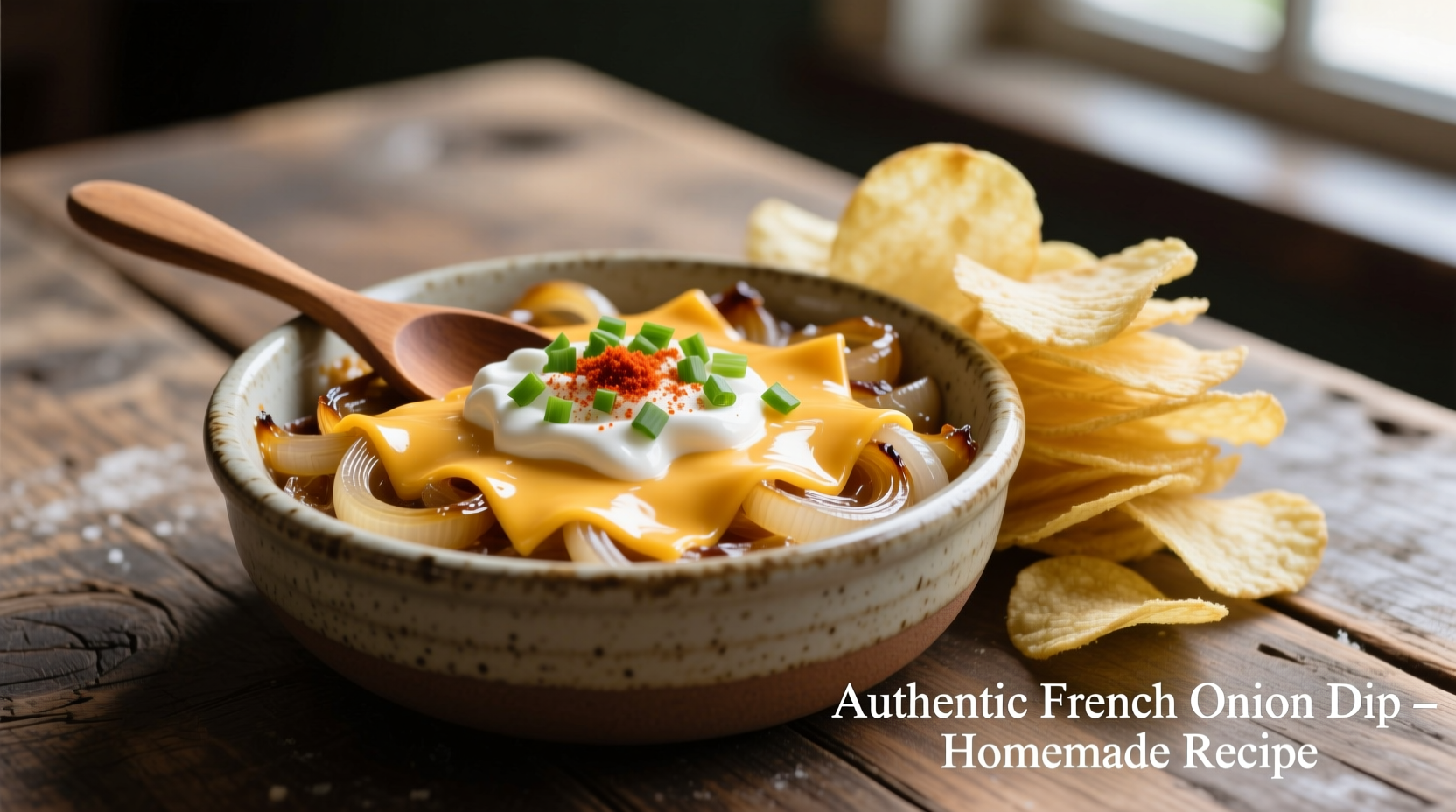If you're searching for the perfect French onion dip recipe, you've found it. Authentic French onion dip requires caramelized onions, quality sour cream, and a few key seasonings—not soup mix. This guide delivers a restaurant-quality version in under 45 minutes with proper technique for deep flavor development.
French onion dip isn't actually French—it's an American creation that became popular in the 1950s. Despite its misleading name, this creamy, onion-forward dip has secured its place as a party staple across North America. Forget the powdered soup mix versions; the real deal uses slowly caramelized onions that transform sweet and complex, creating a dip worthy of your finest potato chips or vegetable crudités.
The Evolution of French Onion Dip: From Kitchen Experiment to Party Essential
While French onion soup has genuine European roots dating to the 18th century, French onion dip emerged much later in American culinary history. Food historians trace its origins to a 1950s kitchen experiment when a home cook combined caramelized onions with sour cream as a novel alternative to traditional dips.
| Time Period | Development | Key Innovation |
|---|---|---|
| 1950s | First documented recipes | Caramelized onions + sour cream base |
| 1960s | Commercialization begins | Dry soup mix versions hit supermarket shelves |
| 1980s | Restaurant adoption | Upscale versions appear on menus |
| 2010s-Present | Artisanal revival | Return to from-scratch preparation methods |
According to the National Museum of American History, the dip's popularity surged when potato chip companies began marketing it as the "perfect chip companion" in the 1960s. This strategic pairing cemented French onion dip's status as an essential game-day and party food.
Why Caramelization Makes All the Difference
The secret to exceptional French onion dip lies in proper onion caramelization. When onions cook slowly over medium-low heat for 25-30 minutes, their natural sugars break down through the Maillard reaction, creating complex flavor compounds that powdered mixes can't replicate.
"Many home cooks rush the caramelization process," explains culinary expert Sophie Dubois. "Taking the full 30 minutes transforms sharp raw onions into sweet, jammy perfection that forms the soul of authentic French onion dip."

Essential Ingredients for Authentic French Onion Dip
Quality ingredients make the difference between ordinary and extraordinary French onion dip. Here's what you need:
- Yellow onions (2 large) - Their balanced sweetness and pungency create ideal flavor
- Unsalted butter (3 tbsp) - Provides rich base without overpowering salt
- Extra-virgin olive oil (1 tbsp) - Prevents butter from burning during long cooking
- Sour cream (1 cup) - Full-fat for best texture and tang
- Mayonnaise (1/4 cup) - Adds richness and helps emulsify the dip
- Fresh thyme (1 tsp) - Earthy note that complements onions
- Worcestershire sauce (1 tsp) - Umami depth without overpowering
- Freshly ground black pepper - Bright finish
Step-by-Step Preparation Guide
Follow these steps for restaurant-quality French onion dip every time:
- Caramelize the onions - Thinly slice onions. Melt butter with olive oil in skillet over medium-low heat. Add onions and cook slowly, stirring occasionally, until deeply golden (25-30 minutes). Deglaze pan with 1 tbsp water if sticking occurs.
- Cool completely - Transfer onions to bowl and refrigerate 20 minutes. This prevents the sour cream from breaking.
- Combine ingredients - In medium bowl, mix cooled onions, sour cream, mayonnaise, thyme, Worcestershire sauce, and black pepper.
- Chill thoroughly - Cover and refrigerate at least 2 hours (overnight preferred) to allow flavors to meld.
- Adjust seasoning - Before serving, taste and adjust pepper or add pinch of flaky sea salt if needed.
Perfect Pairings: What to Serve with French Onion Dip
While potato chips remain the classic vehicle, French onion dip shines with numerous options:
- Traditional - Kettle-cooked potato chips, ruffled chips, or French fries
- Vegetable crudités - Bell pepper strips, cucumber rounds, radishes, celery sticks
- Bread options - Baguette slices, pita chips, crostini
- Protein pairings - Grilled chicken skewers, steak bites, roasted mushrooms
For entertaining, consider setting up a French onion dip bar with multiple dippers and garnish options like fresh chives or smoked paprika.
Regional Variations Worth Trying
Culinary traditions have created interesting French onion dip variations across North America:
- Midwestern Style - Adds a touch of dill and serves with rye toast points
- California Gourmet - Incorporates roasted garlic and serves with artisanal potato chips
- Texas Smoked - Uses smoked onions and a dash of chipotle for subtle heat
- Canadian Pub Style - Features beer-braised onions and serves with French fries
When adapting recipes for different occasions, consider these context boundaries:
- For casual gatherings, stick with classic preparation and serve with quality potato chips
- For upscale events, elevate with artisanal ingredients and elegant presentation
- Avoid adding vinegar-based ingredients which can cause the sour cream to curdle
- Never substitute dried thyme for fresh in this recipe—the flavor profile changes significantly
Storage and Make-Ahead Tips
French onion dip keeps well when stored properly:
- Refrigerate in airtight container for up to 5 days
- Do not freeze—the dairy components will separate upon thawing
- Flavor improves after 24 hours as ingredients fully meld
- If liquid separates, simply stir gently before serving
For best results, prepare the dip one day before your event. The extended chilling time allows the complex flavors to develop fully while giving you one less thing to worry about on the day of your gathering.
Common Questions About French Onion Dip
Here are answers to frequently asked questions about making perfect French onion dip:
Can I make French onion dip without sour cream?
Yes, but the texture and flavor will differ significantly. Full-fat Greek yogurt makes the best substitute, though it will be tangier. For closest results, use 3/4 cup Greek yogurt and 1/4 cup mascarpone cheese to mimic sour cream's richness.
Why does my French onion dip taste bitter?
Bitterness usually comes from burned onions during caramelization. Cook onions over medium-low heat, stirring occasionally, and deglaze the pan with water if brown bits form. Never rush the caramelization process—properly cooked onions should be deep golden, not blackened.
How can I make French onion dip healthier?
For a lighter version, substitute half the sour cream with plain Greek yogurt. Reduce the butter to 1.5 tablespoons and increase olive oil to 1.5 tablespoons. The dip will still have excellent flavor with less saturated fat, though the texture will be slightly less rich.
What's the difference between French onion dip and California dip?
California dip is essentially French onion dip with added garlic. The "California" designation emerged in the 1980s when garlic became trendy in West Coast cuisine. Authentic French onion dip should feature pure onion flavor without competing garlic notes.
Can I use red onions for French onion dip?
Yellow onions provide the best balance of sweetness and pungency for traditional French onion dip. Red onions contain more sugar and anthocyanins that can turn the dip an unappetizing blue-gray color when combined with dairy. If using red onions, limit to no more than 25% of your total onion mixture.











 浙公网安备
33010002000092号
浙公网安备
33010002000092号 浙B2-20120091-4
浙B2-20120091-4